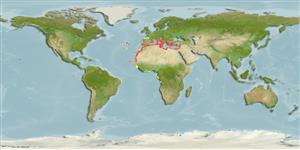Common names from other countries
Environment: milieu / climate zone / depth range / distribution range
Ecologia
; intervalo de profundidade 10 - 700 m (Ref. 106272), usually 30 - 150 m (Ref. 435). Subtropical; 46°N - 14°N, 32°W - 36°E
Eastern Atlantic and the Mediterranean: from the Sahara to the coast of Portugal and Israel in the Mediterranean.
Length at first maturity / Tamanho / Peso / Idade
Maturity: Lm ? range ? - ? cm Max length : 10.0 cm CL macho/indeterminado; (Ref. 84401)
Carapace width: 9.2 cm (Ref. 435). Sublittoral, typically burrows in inshore soft bottoms (Ref. 106272). Also burrows in sand at depths of 13 to 400 m, common at depths of 30 to 150 m (Ref. 435). Found on a variety of bottoms -- sandy, shell grit, hard rocks and coral (Ref. 106272). Reported on upper to middle slope as well as in a seamount (Ref.106167). Infaunal feeder preying on bivalves and foraminiferans (Ref. 52384).
Life cycle and mating behavior
Maturidade | Reprodução | Desova | Ovos | Fecundidade | Larvas
Members of the order Decapoda are mostly gonochoric. Mating behavior: Precopulatory courtship ritual is common (through olfactory and tactile cues); usually indirect sperm transfer.
Fischer, W., G. Bianchi and W.B. Scott (eds.). 1981. (Ref. 435)
Categoria na Lista Vermelha da IUCN (Ref. 130435)
Categoria CITES (Ref. 108899)
Not Evaluated
Not Evaluated
Utilização humana
Pescarias: espécies comerciais
| FishSource |
Ferramentas
Fontes da internet
Estimates based on models
Preferred temperature
(Ref.
115969): 13.3 - 19.2, mean 15.4 (based on 212 cells).
Resiliência
Elevada, tempo mínimo de duplicação da população menor que 15 meses (K=0.31).
Vulnerabilidade
Low vulnerability (10 of 100).
Categoria de preço
Unknown.
